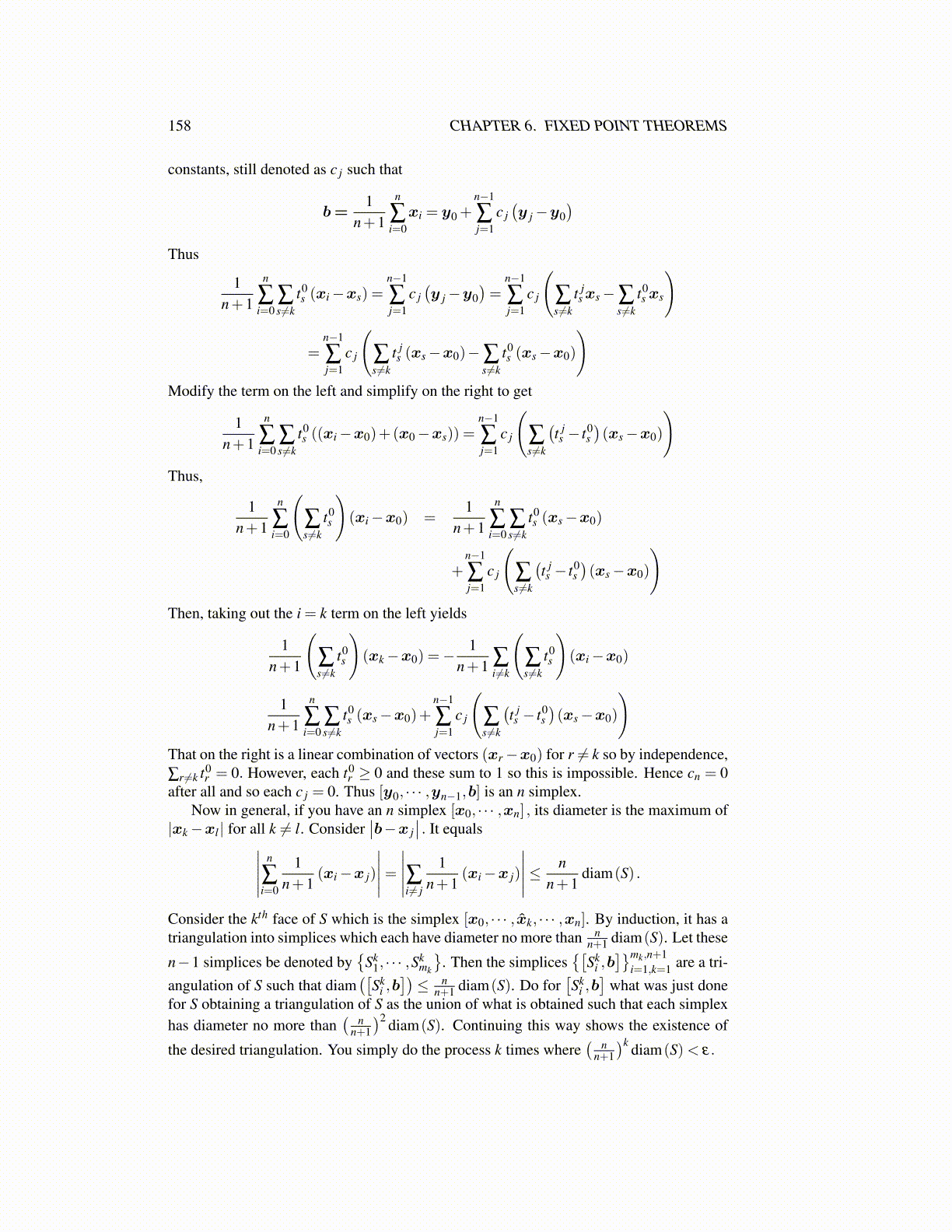
158 CHAPTER 6. FIXED POINT THEOREMS
constants, still denoted as c j such that
b=1
n+1
n
∑i=0xi = y0 +
n−1
∑j=1
c j(y j−y0
)Thus
1n+1
n
∑i=0
∑s̸=k
t0s (xi−xs) =
n−1
∑j=1
c j(y j−y0
)=
n−1
∑j=1
c j
(∑s̸=k
t jsxs−∑
s ̸=kt0s xs
)
=n−1
∑j=1
c j
(∑s ̸=k
t js (xs−x0)−∑
s ̸=kt0s (xs−x0)
)Modify the term on the left and simplify on the right to get
1n+1
n
∑i=0
∑s ̸=k
t0s ((xi−x0)+(x0−xs)) =
n−1
∑j=1
c j
(∑s̸=k
(t js − t0
s)(xs−x0)
)Thus,
1n+1
n
∑i=0
(∑s ̸=k
t0s
)(xi−x0) =
1n+1
n
∑i=0
∑s ̸=k
t0s (xs−x0)
+n−1
∑j=1
c j
(∑s ̸=k
(t js − t0
s)(xs−x0)
)Then, taking out the i = k term on the left yields
1n+1
(∑s ̸=k
t0s
)(xk−x0) =−
1n+1 ∑
i̸=k
(∑s ̸=k
t0s
)(xi−x0)
1n+1
n
∑i=0
∑s ̸=k
t0s (xs−x0)+
n−1
∑j=1
c j
(∑s ̸=k
(t js − t0
s)(xs−x0)
)That on the right is a linear combination of vectors (xr−x0) for r ̸= k so by independence,∑r ̸=k t0
r = 0. However, each t0r ≥ 0 and these sum to 1 so this is impossible. Hence cn = 0
after all and so each c j = 0. Thus [y0, · · · ,yn−1,b] is an n simplex.Now in general, if you have an n simplex [x0, · · · ,xn] , its diameter is the maximum of
|xk−xl | for all k ̸= l. Consider∣∣b−x j
∣∣ . It equals∣∣∣∣∣ n
∑i=0
1n+1
(xi−x j)
∣∣∣∣∣=∣∣∣∣∣∑i ̸= j
1n+1
(xi−x j)
∣∣∣∣∣≤ nn+1
diam(S) .
Consider the kth face of S which is the simplex [x0, · · · , x̂k, · · · ,xn]. By induction, it has atriangulation into simplices which each have diameter no more than n
n+1 diam(S). Let these
n−1 simplices be denoted by{
Sk1, · · · ,Sk
mk
}. Then the simplices
{[Sk
i ,b]}mk,n+1
i=1,k=1 are a tri-angulation of S such that diam
([Sk
i ,b])≤ n
n+1 diam(S). Do for[Sk
i ,b]
what was just donefor S obtaining a triangulation of S as the union of what is obtained such that each simplexhas diameter no more than
( nn+1
)2 diam(S). Continuing this way shows the existence of
the desired triangulation. You simply do the process k times where( n
n+1
)k diam(S)< ε.